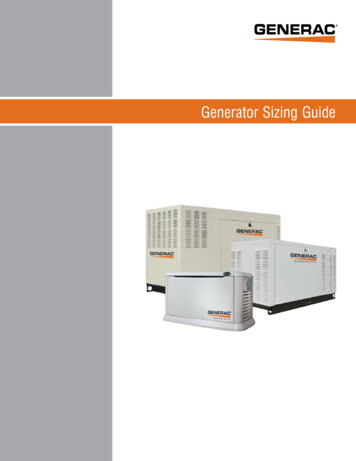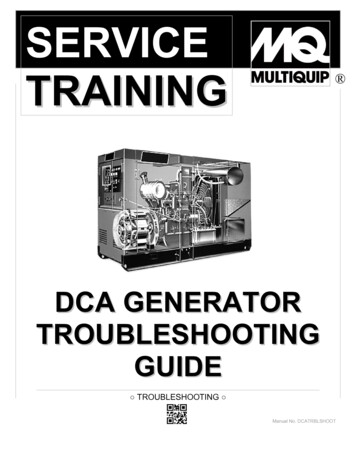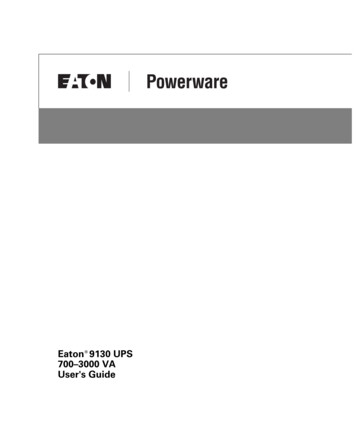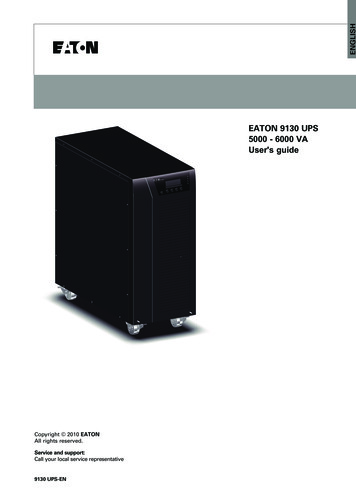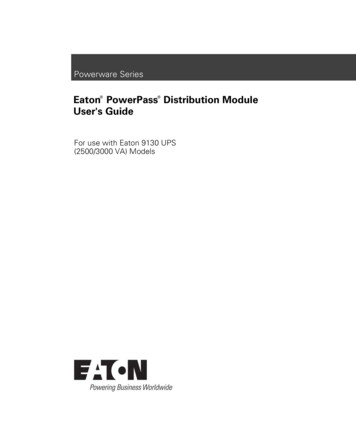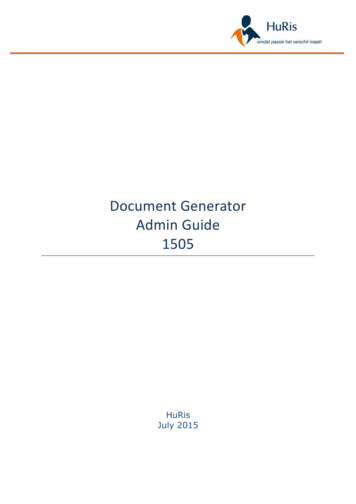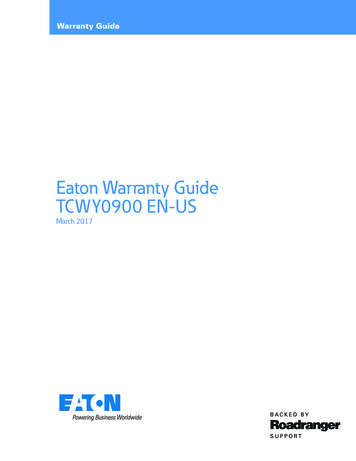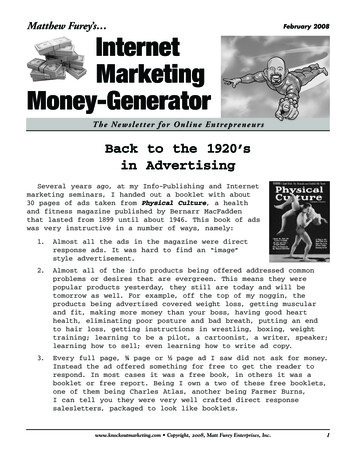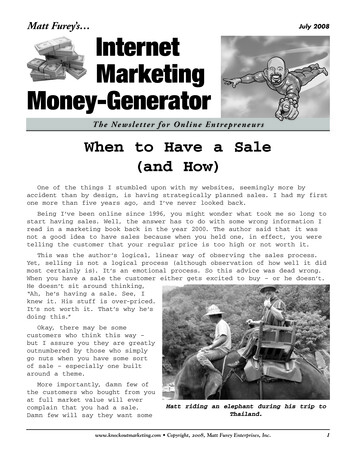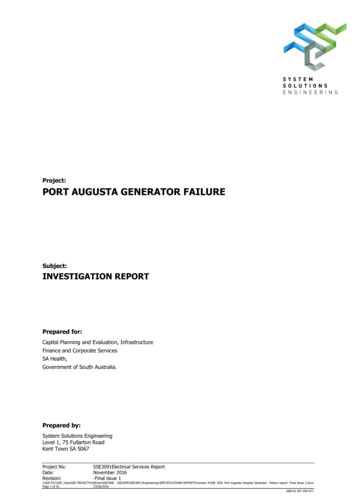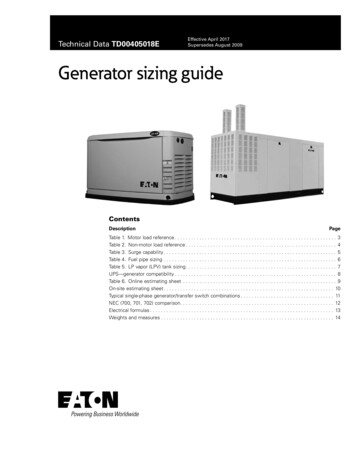
Transcription
Technical Data TD00405018EEffective April 2017Supersedes August 2009Generator sizing guideContentsDescriptionPageTable 1. Motor load reference. . . . . . . . . . . . . . . . . . . . . . . . . . . . . . . . . . . . . . . . . . . . . . . . . . . . . . . . . . . . 3Table 2. Non-motor load reference. . . . . . . . . . . . . . . . . . . . . . . . . . . . . . . . . . . . . . . . . . . . . . . . . . . . . . . . 4Table 3. Surge capability. . . . . . . . . . . . . . . . . . . . . . . . . . . . . . . . . . . . . . . . . . . . . . . . . . . . . . . . . . . . . . . . 5Table 4. Fuel pipe sizing. . . . . . . . . . . . . . . . . . . . . . . . . . . . . . . . . . . . . . . . . . . . . . . . . . . . . . . . . . . . . . . . 6Table 5. LP vapor (LPV) tank sizing. . . . . . . . . . . . . . . . . . . . . . . . . . . . . . . . . . . . . . . . . . . . . . . . . . . . . . . . 7UPS—generator compatibility. . . . . . . . . . . . . . . . . . . . . . . . . . . . . . . . . . . . . . . . . . . . . . . . . . . . . . . . . . . . 8Table 6. Online estimating sheet . . . . . . . . . . . . . . . . . . . . . . . . . . . . . . . . . . . . . . . . . . . . . . . . . . . . . . . . . 9On-site estimating sheet. . . . . . . . . . . . . . . . . . . . . . . . . . . . . . . . . . . . . . . . . . . . . . . . . . . . . . . . . . . . . . . 10Typical single-phase generator/transfer switch combinations. . . . . . . . . . . . . . . . . . . . . . . . . . . . . . . . . . . 11NEC (700, 701, 702) comparison. . . . . . . . . . . . . . . . . . . . . . . . . . . . . . . . . . . . . . . . . . . . . . . . . . . . . . . . . 12Electrical formulas. . . . . . . . . . . . . . . . . . . . . . . . . . . . . . . . . . . . . . . . . . . . . . . . . . . . . . . . . . . . . . . . . . . . 13Weights and measures. . . . . . . . . . . . . . . . . . . . . . . . . . . . . . . . . . . . . . . . . . . . . . . . . . . . . . . . . . . . . . . . 14
Technical Data TD00405018EGenerator sizing guide Effective April 2017Important noticeSafety informationThis booklet is designed to familiarize estimators and installers withproper sizing guidelines for residential and commercial generators.The information is not comprehensive, nor does it replace orsupersede any material contained in any of the written documentsshipped with the equipment. This booklet should only be used inconjunction with the Owner’s Manual, Installation Manual, and othertechnical documents shipped with each product. Always read allaccompanying documentation carefully before attempting to installany generator, transfer switch, or related equipment.Proper sizing of the generator is crucial to the success of anyinstallation and requires a good working knowledge of electricityand its characteristics, as well as the varying requirements ofthe electrical equipment comprising the load. When analyzingthe electrical load, consult the manufacturer’s nameplate on eachmajor appliance or piece of equipment to determine its startingand running requirements in terms of watts, amps, and voltage.When choosing the generator output for commercial or industrialapplications, select a rating that is approximately 20 to 25% higherthan the peak load (for example, if the load is about 40 kilowatts,select a 50 kW genset). A higher rated generator will operatecomfortably at approximately 80% of its full capacity and willprovide a margin of flexibility if the load increases in the future.How to use this bookletWithin this booklet, you will find electrical load information, plus anoutline of generator surge capability, fuel pipe sizing, liquid propanetank sizing, and UPS/generator compatibility. The worksheet pagescan be removed from the book and photocopied to create additionalOn-site Estimating Sheets for use with individual jobs.For safety reasons, Eaton recommends that the backup power systembe installed, serviced, and repaired by an Eaton Authorized ServiceDealer or a competent, qualified electrician or installation technicianwho is familiar with applicable codes, standards, and regulations.It is essential to comply with all regulations established by theOccupational Safety & Health Administration (OSHA) and strictadherence to all local, state, and national codes is mandatory.Before selecting a generator, check for municipal ordinances thatmay dictate requirements regarding placement of the unit (setbackfrom building and/or lot line), electrical wiring, gas piping, fuel storage(for liquid propane or diesel tanks), sound and exhaust emissions.If you have a technical question regarding sizing or installation,contact EatonCare’s Technical Resource Center toll free at1-877-386-2273, option 2 during normal business hours(8 a.m. to 4 p.m. CST).2EATON www.eaton.com
Technical Data TD00405018EGenerator sizing guide Effective April 2017 Table 1. Motor load referenceac and heat pumpsDescription1 ton (12,000 BTU)2 ton (24,000 BTU)3 ton (36,000 BTU)4 ton (48,000 BTU)5 ton (60,000 BTU)7.5 ton (85,000 BTU)10 ton (120,000 BTU) a10 ton (120,000 BTU)15 ton (180,000 BTU) a15 ton (180,000 BTU)20 ton (240,000 BTU) a20 ton (240,000 BTU)25 ton (300,000 BTU)30 ton (360,000 BTU) a30 ton (360,000 BTU)40 ton (480,000 BTU) a40 ton (480,000 BTU)50 ton (480,000 BTU) a50 ton (480,000 BTU)Running loadStarting hpRunningkWAmps at240 VAmps at208 VAmps at240 VAmps at480 VLR ampsat 240 VLR ampsat 208 VLR ampsat 240 VLR ampsat 480 VkW123457.55 (x2)107.5 (x2)1510 (x2)202515 (x2)3020 (x2)4025 unningkWAmpsat 120 V4.9 ampsat 240 VLR ampsat 240 VLR ampsat 120 19.64.99.825505010036General residentialSingle-phaseDescriptionRefrigerator pump, sump,furnace, garage openerFreezer, washer,septic grinderGeneral 1 hpWell and septic lift pumpSingle-phasea For multiple motor configurations, sequence starting is assumed.m CAUTIONDO NOT SIZE THE GENERATOR BASED ON STARTING KW ALONE.YOUMUST COMPARE LR AMPS TO GENERATOR SURGE CAPABILITY (TABLE 3).SIZE THE GENERATOR BY FOLLOWING THE SIZING INSTRUCTIONS.EATON www.eaton.com3
Technical Data TD00405018EGenerator sizing guide Effective April 2017Table 2. Non-motor load referenceResidentialRunning load aSingle-phaseDescriptionElectric heat per 1000 ft 2Heat pump elements per 1000 ft 2DryerHot tubRange oven/stove top per burnerHot waterGeneral lighting and receptaclesper 1000 ft 2Blow dryerDishwasherMicrowaveToastersHome entertainment centerComputerKitchenLaundryRunningkWAmps at120 VAmps at240 /AN/AN/AN/AN/AN/AN/ACommercialPlease refer to equipment data plate and/or billing history for commercial details.a Always check data plate for actual running amps.4EATON www.eaton.com
Technical Data TD00405018EGenerator sizing guide Effective April 2017 Table 3. Surge capabilityGenerators (operating at less than 3600 RPM)Size (kW)2225273035364045487080100130Rated output (running amps)Commercial (LR amps at 15% voltage dip)Residential (LR amps at 30% voltage Single-phase240 V208 V240 V480 V240 V208 V240 V480 V240 V208 V240 V480 7112112190212255419Three-phaseGenerators (operating at 3600 506255204512265583723222151121747647431NNote: All nominal ratings based upon LP fuel. Refer to specification sheet for NG ratings and deration adjustments for ambient temperature and altitude.EATON www.eaton.com5
Technical Data TD00405018EGenerator sizing guide Effective April 2017Table 4. Fuel pipe sizingLPNatural gas (values are maximum pipe run in ft) LPG: 8.55 ft3/lb, 4.24 lb/gal,2500 btu/ft3 LPG: 36.3 ft3 1 0607080100130150Pipe size (in 505025522.53Natural 0585560390225195140503011857106304602151502.53Pipe size (in ATON www.eaton.com1.251.521 cubic foot 1,000 BTU 1 therm 100,000 BTU Gas consumption 13,000–16,000 BTU per kW/hrPressureLP vapor (values are maximum pipe run in ft)kW 1 inch mercury 13.61inches water column 1 inch water column 0.036 psi 5–14 inches water column 0.18 psi to 0.50 psiNote: Pipe sizing is based on 0.5 inH2O pressure drop Sizing includes a nominalnumber of elbows and tees Please verify adequateservice and meter sizing
Technical Data TD00405018EGenerator sizing guide Effective April 2017 Table 5. LP vapor (LPV) tank sizingVapor withdrawal (dimensions are given in inches)Tank capacitytotal (gal)Tank capacityuseable (gal)Minimumtemp ( F)Tank ,700811,800405,9001,416,960944,640472,320Load 300BTU/hrLP gal/hrNG ft3/hrNG 9.0NNote: Operating cost per hour NG therms/hr x cost of NG therms.LengthDiameterOverall 50Gas required for common appliancesApproximateinput (btu/hr)ApplianceWarm air furnaceSingle familyMultifamily, per unitHydronic boiler, space heatingSingle familyMultifamily, per unitHydronic boiler, space and water heatingSingle familyMultifamily, per unitRange, free standing, domesticBuilt-in oven or broiler unit, domesticBuilt-in top unit, domesticWater heater, automatic storage, 30 to 40 gal. tankWater heater, automatic storage, 50 gal. tankWater healer, automatic storage, instantaneous2 gpm4 gpm6 gpmWater heater, domestic, circulating or side-armRefrigeratorClothes dryer, Type 1 (domestic)Gas fireplace direct ventGas logBarbecueGas lightIncinerator, ,0003,00035,00040,00080,00040,0002,50035,000NNote: Tank BTU capacity and generator run times based upon maintaining aminimum tank fuel level of 20%. Tanks are typically filled to 80% full. Typicalfuel consumption based on a generator 100% loaded.EATON www.eaton.com7
Technical Data TD00405018EGenerator sizing guide Effective April 2017UPS—generator compatibilityPassive (also referenced as standby or offline)and line-interactiveThese technologies are most common for personal workstationsand point-of-sale applications. They are typically single-phaseequipment with size ranges of 350–2000 VA for passive and500 VA to 5000 VA for line-interactive.Passive UPSs are the simplest type. Under normal conditions, acpower passes straight through to the UPS load. When the inputpower supply goes outside of specifications, the UPS transfersthe load from input power to the internal dc to ac power inverter.Passive UPSs do not correct for voltage or frequency deviationsunder “normal” operation.Line-interactive is similar to the passive technology except it hascircuitry that attempts to correct for standard voltage deviations.Frequency deviations under “normal” power operation are notcorrected.Equipment notesThese devices tend to be electrically/harmonically very noisy. Asingle small UPS is not a significant concern, but applications withmultiple UPSs can be problematic.Passive UPS technology typically has normal tolerances of 10–25%on voltage and 3 Hz on frequency. If the input source goes outsideof these tolerances, the UPS will switch onto the UPS batterysource. Some line-interactive units may have frequency tolerancesfactory set to 0.5 Hz. These units will need to have their frequencytolerance increased to a minimum of 2 Hz.Generator sizing recommendationDouble-conversionThis technology is most common for critical load applications.Double-conversion UPSs constantly rectify ac to dc and then invertthe dc back into ac. This configuration results in an output thatcorrects for voltage and frequency deviations.There
Generator sizing guide EATON www.eaton.com Table 1. Motor load reference ac and heat pumps Running load Starting load Description hp Running kW Single-phase Three-phase Single-phase Three-phase kW Amps at 240 V Amps at 208 V Amps at 240 V Amps at 480 V LR amps at 240 V LR amps at 208 V LR amps at 240 V LR amps at 480 V 1 ton (12,000 BTU) 1 1 5 .
